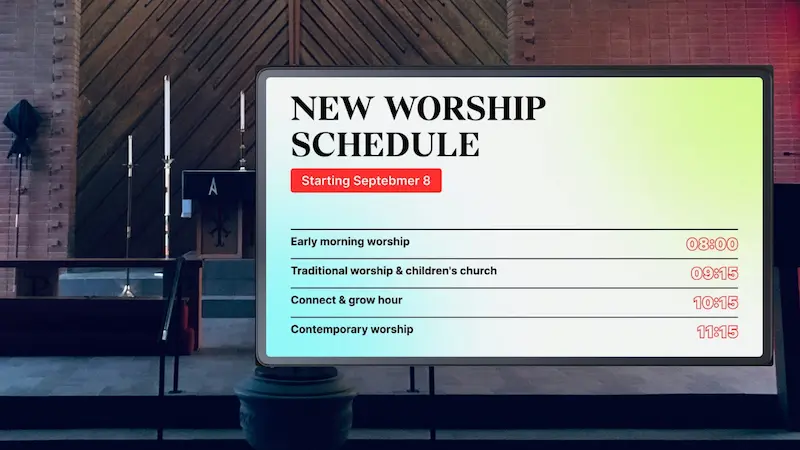
Table of Content
Have you ever found yourself staring blankly at the floor numbers during an elevator ride? Elevator digital signage transforms those awkward, silent moments into opportunities for information and entertainment. From building announcements and local news to captivating visuals and promotions, these displays add value to the user experience within a building.
Elevator Digital Signage: An Overview
Elevator digital signage refers to the use of digital displays within elevator cabs or elevator lobbies. These displays show a variety of content, often tailored to the specific building or audience.
Benefits of Elevator Digital Signage
- Revenue generation: Elevator rides might be short, but their marketing potential is huge. By offering advertising space to local businesses or promoting your services, you can generate advertising revenue or offset the costs associated with installing and maintaining the digital signage system.
- Gaining Insights on Passengers: Understanding the patterns and demographics of your elevator users helps you better optimize the space. By integrating with AI, elevator digital signage systems can provide you with valuable data on peak usage, audience demographics, and content engagement. These insights can help you tailor future content or identify potential issues and opportunities within the building.
- Captive Audience: Elevator rides provide a unique moment of focused attention. People naturally seek out distractions, and digital signage becomes a welcome source of information or entertainment during short trips.
- Targeted Messaging: Elevator screens let you deliver targeted messaging throughout the day based on specific demographics and audiences. You can display critical updates during high-traffic hours or promote on-site amenities when people are most likely to use them.
How to Implement Elevator Digital Signage
Choosing the Right Hardware
Choosing the right hardware is essential for both effectiveness and long-term functionality. Opt for LCD or LED displays with screen sizes that strike a balance between visibility and the limited space inside the elevator car. These will require that you use a media player for content playback on the screens. However, you can also use an Android, Mac OS, or Windows device to eliminate the need for media players since you can install the digital signage software on the tablet.
Due to vibrations and potential temperature fluctuations in elevators, select displays and media players are specifically designed for the rigors of commercial use. They should feature protective characteristics such as dustproofing and shock resistance.

Installing and Mounting Screens in Elevators
The method of installation and mounting often depends on elevator design, available space, budget, and installation complexity. Here are some common ways to install and mount digital signage screens in elevators:
- Wall-mounted screens: Here you mount the screens directly on the elevator walls. This method requires a suitable flat surface and involves using brackets or mounting arms to secure the screen. Most often, vertical-oriented digital signage is used for this type of space.
- Overhead-mounted screens: In this approach, the screens are mounted on the ceiling of the elevator. It offers a clear line of sight for viewers and can be a good option if wall space is limited. Mounting brackets or suspended mounting systems can be used to secure the screens.
- Integrated screens: Some modern elevator manufacturers offer integrated digital signage solutions. These screens are built into the elevator structure during manufacturing to provide a streamlined and cohesive appearance. Integrated screens can be mounted in various locations, such as elevator doors or panels.
- Retrofitting existing screens: If the elevator already has traditional static signage or older display screens, it may be possible to retrofit them with screens. Retrofitting involves removing the existing signage and replacing it with new screens, ensuring compatibility with the elevator structure and power supply.

Content Creation and Management
At this stage, focus on creating brief and high-impact content due to the short nature of elevator rides. Include a mix of building announcements, news updates, light entertainment, and relevant advertisements.
Make use of a dedicated digital signage content management system (CMS) to simplify the creation, editing, scheduling, and remote updating of your content. Leaning on the CMS's templates, content feeds, and organizational tools will further streamline the process. Regularly refresh your content, use available analytics to track viewership, and make adjustments to improve its effectiveness.

Best Practices for Elevator Digital Signage
Designing Engaging Content for Elevator Screens
Understand your audience: The content you design should align with the demographics, interests, and preferences of the elevator audience. If your elevator serves, for example, a corporate environment, professional and informative content may be more suitable.
Keep it concise and eye-catching: Elevator dwell times are typically short, so make sure your content is concise and can be quickly understood. Use attention-grabbing headlines, vibrant colors, and bold imagery to capture viewers' attention and convey your message efficiently.
Include clear and concise text: If you use text in your content, keep it brief and easy to read. Use large, legible fonts and contrasting colors to ensure readability.
Incorporate motion and interactivity: Movement and interactive elements can enhance engagement. Consider using subtle motion graphics or animations to draw attention to specific areas of the screen. Interactive elements such as touchscreens or motion sensors can provide an interactive experience that allows viewers to interact with the content.
Ensuring Compliance and Safety
During the installation phase, check local regulations, building codes, and even elevator manufacturer guidelines regarding installing technology within elevators. You may need permits or require specific mounting methods to ensure safety.
Your elevator digital signage should also not interfere with the proper functioning of the elevator or compromise passenger safety during emergencies. Ensure the signage does not obstruct emergency exit signs, fire alarms, or contact information in an emergency. Leave clear visibility and easy access to essential safety equipment and controls.
Upgrade Your Building With Elevator Digital Signage
Elevator digital signage has the power to transform elevator rides into engaging moments. From informing and entertaining passengers to driving revenue and optimizing your building's communication. If you're looking for ways to improve communication within your building, attract new advertisers, or simply modernize the daily user experience, consider embracing the power of elevator digital signage.
Implementing and managing this technology is easier than you think. With the user-friendly Look content manager, you'll have robust features for scheduling updates, remote management, and seamless content delivery. Try it with a 14-day trial period today for free!





.webp)

